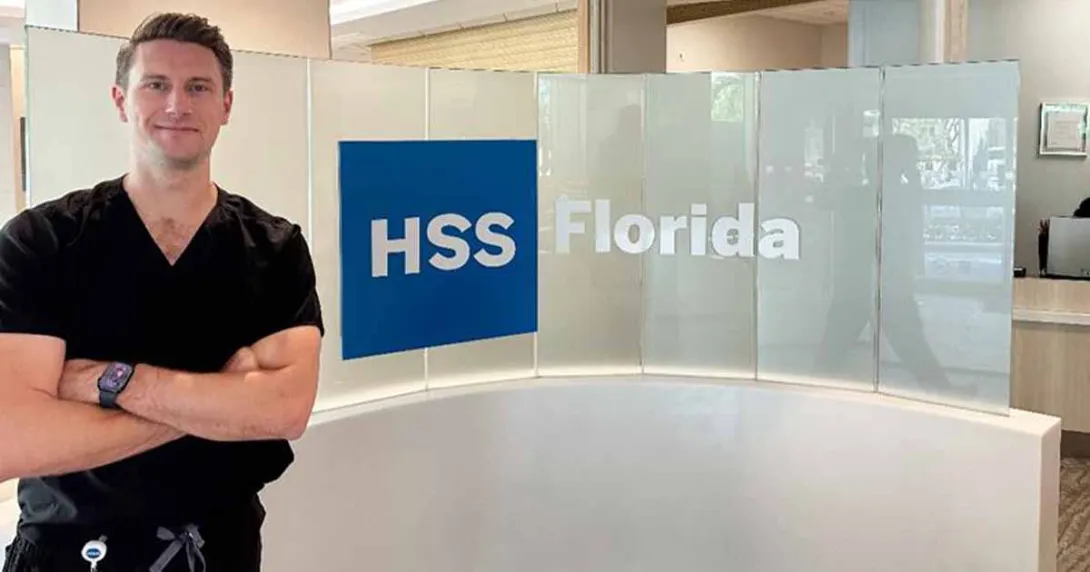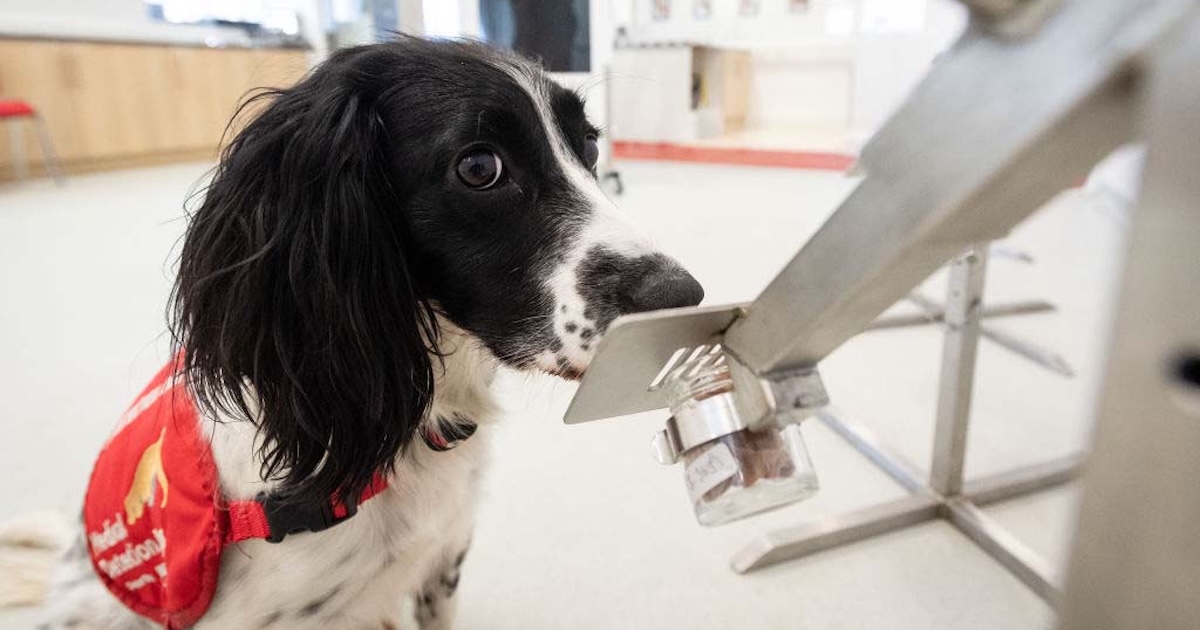
At the Hospital for Special Surgery Florida, located in West Palm Beach, there were a number of difficulties patients encountered in their attempts to successfully recover after knee replacement surgery.
THE CHALLENGE
"First, let's paint the picture of what the standard of care recovery protocol looks like following knee replacement surgery, before the advent of telehealth technology," said Dr. Spencer Summers, attending physician, complex hip and knee reconstruction, at HSS Florida. "The patient undergoes knee replacement surgery and will often undergo a session of physical therapy in the hospital or in the surgery center where the surgery took place. Then, they are sent home.
"Oftentimes, but not always, a home nursing service is contracted to send a physical therapist into the patient's home two to three times a week for a 30- or 45-minute session," he continued. "It is typical for the patient to be sent home with paper instructions of simple exercises from the surgeon's office that they can perform independently in their home."
While this is considered the standard of care, Summers does not believe it is sufficient.
"First and foremost, arranging for a physical therapist to visit a patient's home can be difficult based on the patient's geography and availability of therapists in that area," he explained. "Sometimes, there are difficulties in coordinating the timing of these visits, and some patients prefer to not have therapists come into their homes.
"While patients universally find these sessions helpful, they are relatively short sessions that only occur two to three times per week," he added. "For the other four to five days, physicians can only hope the patient performs the exercises recommended to them at home."
Under the standard protocol, patients often arrived at their first postoperative clinic visit only to be scolded by the surgeon for having a stiff knee and questioned about whether they had followed their prescribed exercises, he noted.
"In response, patients typically insisted they had done as much as they could," Summers said. "The surgeon would then urge them to begin outpatient physical therapy immediately to reduce stiffness and prevent muscle atrophy. The result was often an anxious and tense clinic visit for everyone involved."
PROPOSAL
HSS Florida turned to telehealth technology from vendor ROMTech that directly addresses many of the shortcomings of the traditional postoperative recovery process that concerned Summers.
"First, the technology is highly reliable," he said. "Unlike home health nursing or physical therapy – where scheduling challenges and missed appointments with therapists are common – the telehealth vendor guarantees up to five guided sessions per day during the critical first few weeks after surgery, all from the comfort of the patient's home.
"Second, it delivers the most effective form of exercise for the immediate post-surgical period," he continued. "Knee replacement surgeons have long recommended pedaling exercises following surgery, yet patients often lacked the tools to perform them. The vendor offers a device that bridges that gap, enabling patients to begin therapeutic pedaling exercises right away."
Third, the platform reduces confusion and anxiety for patients by eliminating the guesswork around daily exercises, he added.
"Instead of relying on printed instructions from the surgeon's office or improvising routines on days without therapist visits, patients now follow a simple, structured plan: Use the ROMTech PortableConnect five times a day, and ice and rest their knee in between," Summers explained. "The process is straightforward, consistent and easy to follow."
MEETING THE CHALLENGE
When Summers first learned about this technology, he said it immediately made sense.
"We've long advised patients to perform pedaling-based exercises after knee replacement surgery, but we never actually provided them with the tools to do so effectively," he noted. "From that perspective alone, the device filled a major gap in care.
"During my training, I saw some surgeons incorporate the device into their patients' recovery plans while others did not," he continued. "It quickly became clear in the clinic that the patients using the device were happier and more confident in their early recovery."
The most common word Summers hears from patients describing their experience with the telehealth technology is "empowered."
"They're no longer dependent on a nurse or therapist visiting their home just a few times a week to complete a productive therapy session," he explained. "Instead, they can take control of their recovery by doing up to five sessions per day, every day, during those crucial first weeks after surgery.
"The device allows them to track their progress in real time, observing their strength and endurance improve," he continued. "This creates a positive feedback loop – patients enjoy seeing their progress and are motivated to keep going."
RESULTS
After observing patients in the clinic, it appeared those using the telehealth technology were recovering more quickly than those who weren't. While these anecdotal observations were encouraging, HSS Florida did not want to rely solely on subjective impressions – it wanted objective data to confirm whether patients were truly recovering faster with the device.
"To do so, we conducted a study comparing patient outcomes following knee replacement surgery, both before and after implementing PortableConnect in our recovery protocols," Summers explained. "We performed a retrospective cohort analysis, evaluating patients based on knee range of motion, pain scores and functional outcome scores. The only variable that differed between the two groups was the use of the telehealth device.
"When analyzing pain scores, we found that patients who used the technology reported significantly less pain at two, six and twelve weeks postoperatively," he continued. "Not only was the reduction in pain significant, it also was clinically meaningful, surpassing the minimum clinically important difference (MCID) threshold."
In terms of knee range of motion, patients in the technology group showed greater improvements in knee extension, knee flexion and overall total range of motion at all postoperative time intervals.
"We also assessed functional outcomes using the Knee Injury and Osteoarthritis Outcome Score (KOOS)," Summers said. "These scores were consistently and significantly higher in the telehealth group across all measured time intervals, with differences again exceeding the MCID threshold, highlighting both statistical and clinical relevance.
"Finally, we evaluated cost," he added. "We compared the utilization of healthcare resources – home nursing visits, outpatient physical therapy sessions and other post-op services – between patients following the standard recovery protocol and those using the device. On average, the technology group incurred $2,460 less in total care costs per patient."
ADVICE FOR OTHERS
For healthcare providers interested in updating their recovery protocols following knee replacement surgery, Summers highly encourages them to introduce a tele-rehabilitation option.
"After introducing this technology into my practice, we noticed an immediate increase in patient satisfaction, a decrease in patient phone calls to our office and overall improved patient outcomes," he said. "Tele-rehabilitation offers the skill and reassurance of traditional hands-on therapy visits, but with the added benefit of significantly greater frequency than standard home-based therapy can offer.
"And because it's done from the comfort of the patient's home, it eliminates the logistical challenges of traveling to outpatient therapy centers – particularly during the early postoperative period, when many patients are unable to drive," he noted.
The biggest challenge Summers' team faced when adopting tele-rehabilitation was integrating the ordering process into their surgical scheduling workflow.
"No medical practice wants to add more documentation or insurance hurdles to an already overwhelming workload, but in our experience, the process was surprisingly efficient," he said.
"It takes just one or two additional minutes to arrange the tele-rehabilitation system, saving our team countless hours on the back end," he continued. "With more frequent, structured therapy sessions, patients feel more confident in their recovery, which has significantly reduced the number of phone calls and concerns directed to our office."
Follow Bill's HIT coverage on LinkedIn: Bill Siwicki
Email him: bsiwicki@himss.org
Healthcare IT News is a HIMSS Media publication.
WATCH NOW: Four provider organizations that excel at telehealth and equity


